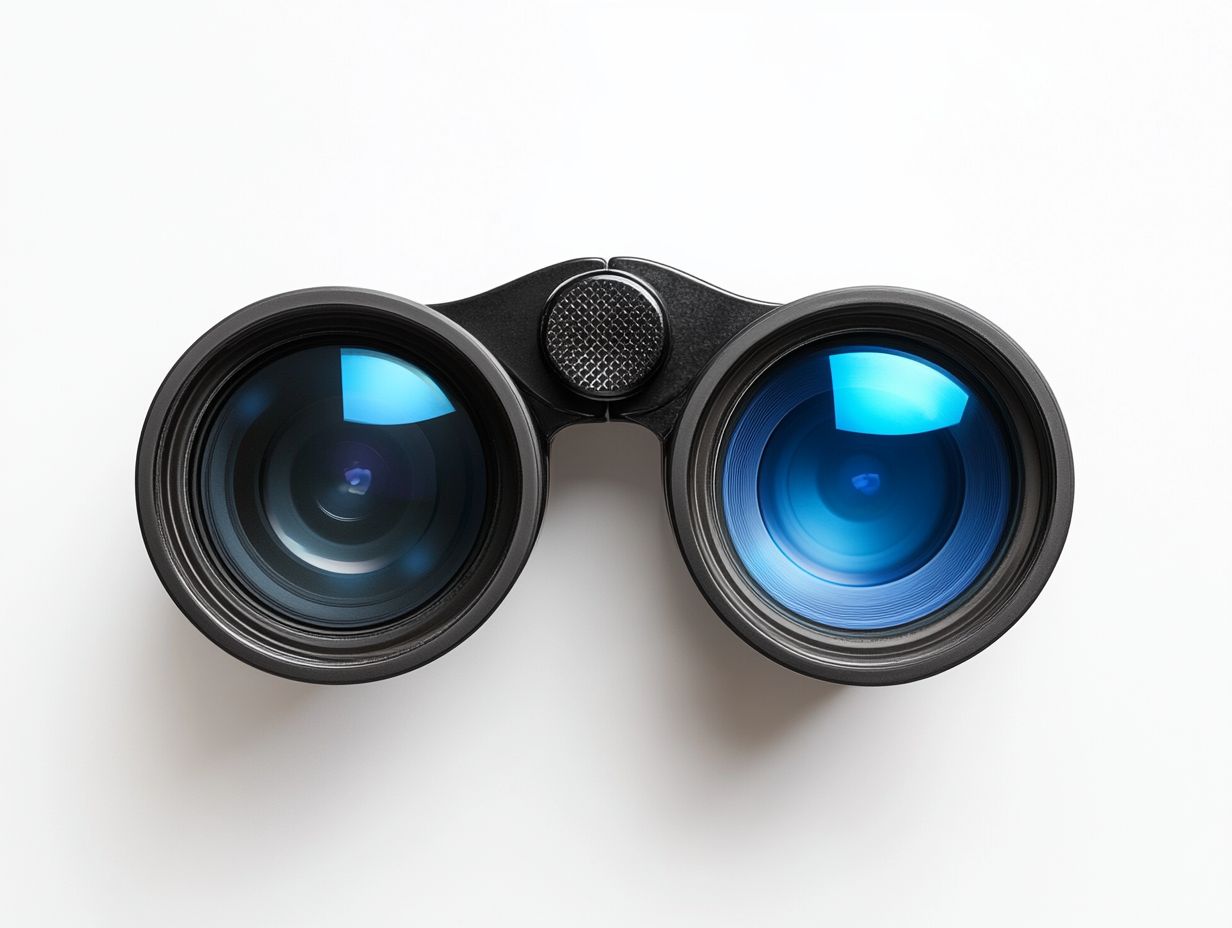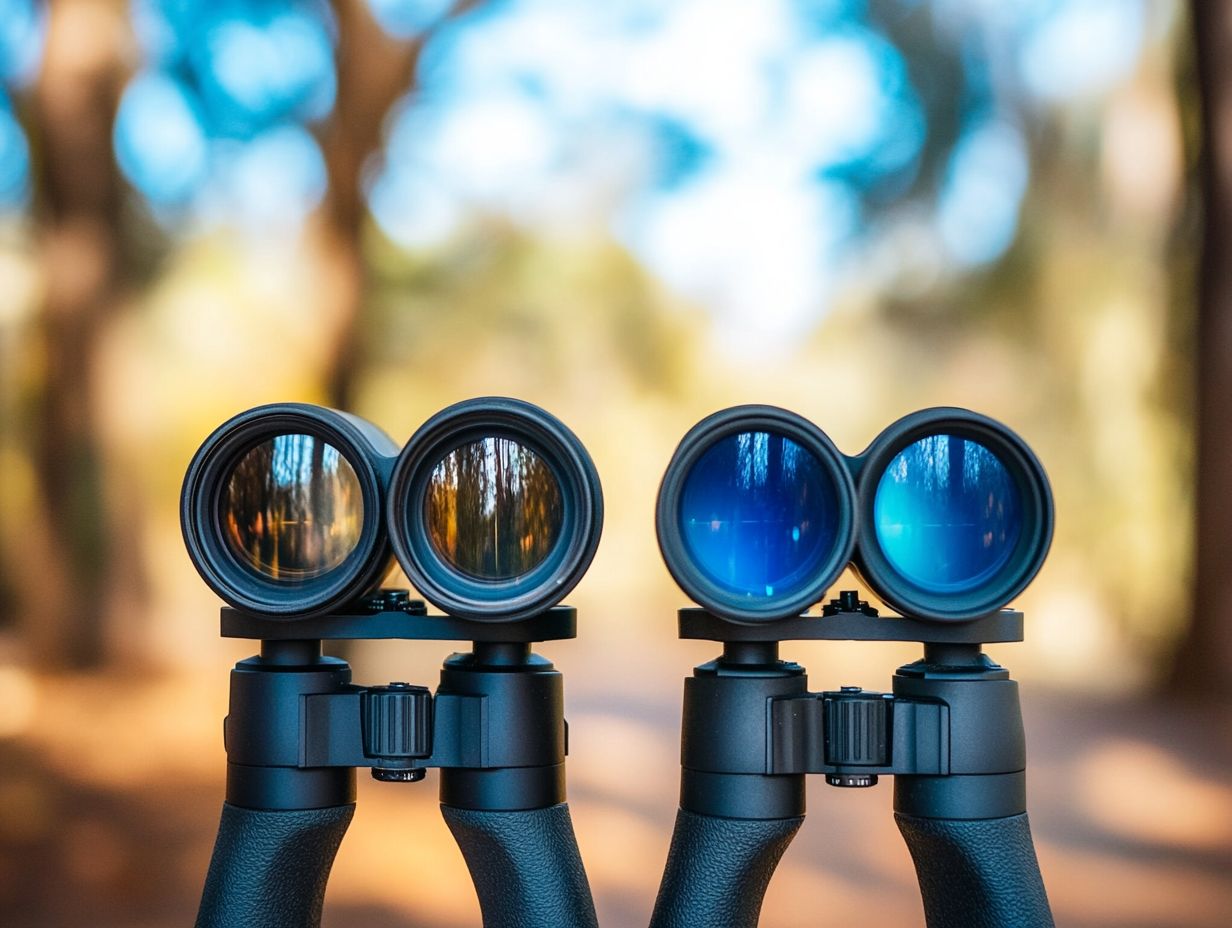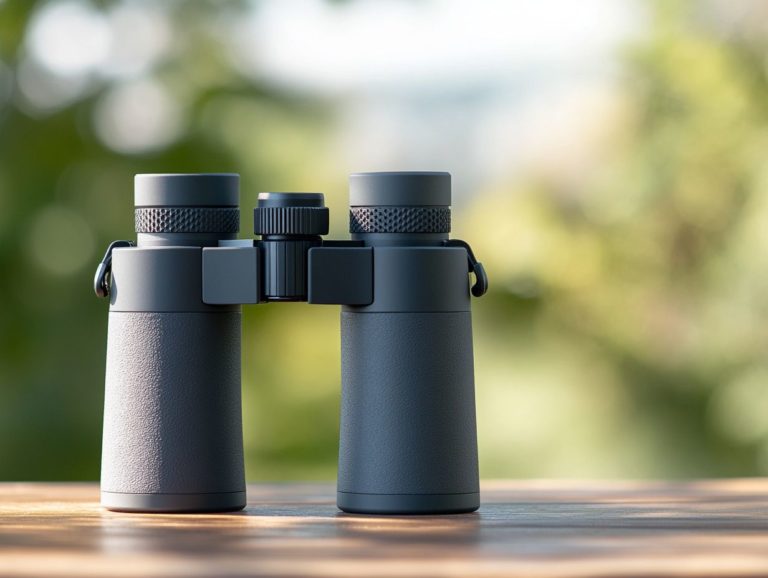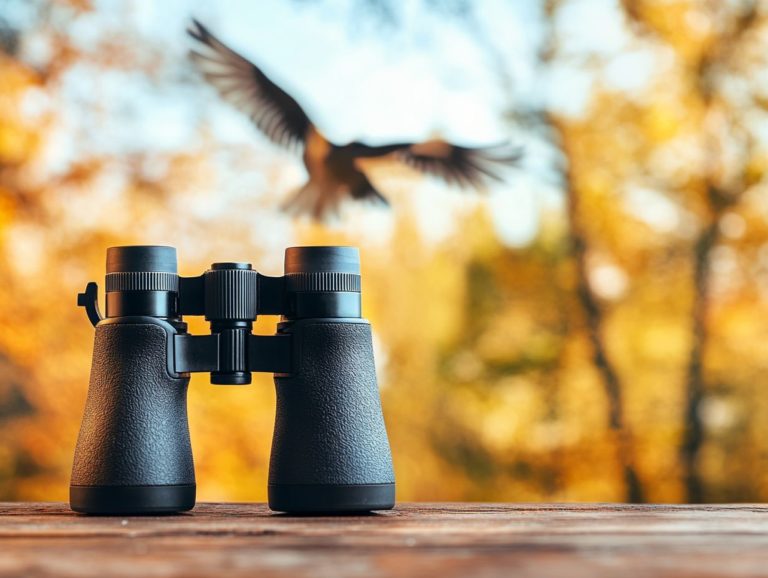The Impact of Lens Coating on Binocular Performance
When it comes to binoculars, the clarity of your view can truly transform your outdoor experiences. One critical element that often slips under the radar is lens coating.
This article explores the different types of lens coatings available and how they can enhance the performance of your binoculars. From improved image quality to reduced glare, you’ll be amazed at how these coatings can transform your viewing experience!
You ll also discover important factors to consider when selecting the right coating, essential maintenance tips, and a clear comparison between coated and non-coated options. By the end of your reading, you ll gain a clearer understanding of how lens coatings can elevate your viewing experience.
Contents
- Discover the Key Benefits of Lens Coatings!
- Understanding Lens Coating
- Effects of Lens Coating on Binocular Performance
- Factors to Consider When Choosing Lens Coating
- Maintaining and Protecting Lens Coating
- Comparing Coated and Non-Coated Binoculars and Scopes
- Frequently Asked Questions
- What is lens coating and how does it impact binocular performance?
- What are the different types of lens coatings available for binoculars?
- How Does Anti-Reflective Coating Improve Binocular Performance?
- Can Lens Coating Affect the Color of the Images Seen Through Binoculars?
- What is the Significance of Anti-Scratch Coating on Binocular Performance?
- How Do Hydrophobic Coatings Improve Binocular Performance in Wet Conditions?
Discover the Key Benefits of Lens Coatings!

- Lens coating enhances binocular performance by improving image quality and reducing glare.
- When choosing lens coating, consider your intended use, environment, budget, and personal preferences.
- Proper maintenance and protection of lens coating are crucial for longevity and optimal performance.
Understanding Lens Coating
Understanding lens coating is crucial for improving the performance of your binoculars and scopes, which rely heavily on optimal light transmission and superior image quality.
The process of applying various lens coatings involves multiple layers of specialized materials. Anti-reflection coatings reduce glare, enhancing visibility.
Coatings like magnesium fluoride and silicon dioxide provide important features such as UV protection and water resistance, ensuring a viewing experience that is nothing short of exceptional.
Types of Lens Coating
Lens coatings are more than just an accessory; they come in various types, each designed to enhance specific optical properties. For example, anti-reflection coatings improve light transmission and image clarity.
These coatings elevate the performance of devices like binoculars. Consider scratch-resistant coatings, often made from silicon dioxide, which add a protective layer that minimizes damage from everyday use.
UV protective coatings shield your eyes from harmful rays a must for any outdoor enthusiast. On the other hand, hydrophobic coatings repel water and oil, helping you maintain a clear view in wet conditions.
By utilizing advanced materials, manufacturers give you greater durability and enhanced visibility, essential for wildlife observation and hunting.
Effects of Lens Coating on Binocular Performance
The effect of lens coating on your binocular performance is significant, influencing aspects like image quality, light transmission, and your overall viewing experience, especially in varying light conditions.
Improved Image Quality
Improved image quality in optical devices comes from advanced lens coatings that enhance light transmission and minimize ghost imaging, delivering visuals that are both clearer and more vibrant.
These specialized coatings act as a protective barrier, allowing usable light to pass through while reducing reflections that can distort images. For example, high-quality binoculars from brands like Swarovski and Zeiss use multi-layer anti-reflective coatings. These coatings not only improve light transmission but also address common issues like flare and ghosting, which can obscure important details.
With this level of performance, you can experience exceptional clarity and contrast across various lighting conditions. This makes these optics a top choice for birdwatchers and outdoor enthusiasts who seek precision in observing nature’s vibrant details.
Reduced Glare and Reflection

Reduced glare and reflection are essential advantages of using anti-reflection coatings on lenses. They significantly enhance the clarity of devices we use to see things clearly in various lighting scenarios.
These coatings minimize light reflection off the lens, letting more light through. They achieve this by applying multiple thin layers of material, each designed to interfere with specific wavelengths of light and effectively cancel out reflections.
For example, when you use high-performance cameras or binoculars, these advanced coatings can dramatically improve image quality, especially when capturing bright landscapes or navigating sunny outdoor conditions.
A case study featuring state-of-the-art eyeglasses showed that users noticed less eye strain and clearer vision while wearing lenses equipped with anti-reflective technology, whether during bright days or nighttime driving.
The positive impact on optical performance under intense lighting conditions is significant!
Factors to Consider When Choosing Lens Coating
When selecting lens coatings for your optical devices, consider several key factors. These include the intended use of the device, environmental conditions, budget limitations, and personal preferences that enhance your viewing experience.
Each of these elements plays a significant role in ensuring you make the most informed choice for your needs.
Intended Use and Environment
The intended use and environment are crucial elements when selecting the right lens coatings for your optical devices. They directly impact the performance you need for activities like hunting or wildlife observation.
For instance, when you re out in bright sunlight, choosing lenses with anti-reflective coatings can significantly reduce glare, enhancing your visibility during exhilarating day trips or outdoor sports.
Conversely, if you find yourself in low-light conditions, such as during an evening hunt, you’ll want lenses that maximize light transmission to ensure every detail is clear when it matters most.
In specific scenarios like military and law enforcement, the choice of specialized coatings becomes even more critical. Tactical lenses often use scratch-resistant and anti-fog coatings to endure various environments while allowing swift response times in high-pressure situations.
Understanding these considerations is vital for unlocking the full potential of your optical equipment.
Budget and Personal Preferences
Your budget and personal preferences significantly influence your decision-making process when selecting lens coatings for your optical devices. It’s important to strike a balance between performance features and cost-effectiveness.
Understanding the nuances of various coatings can feel overwhelming, especially when financial limits narrow down your options. Quality optics can come with a hefty price tag, but they are often essential for achieving optimal performance, particularly in challenging lighting conditions. This leads you to weigh the benefits of advanced coatings against potential savings.
Brand loyalty also shapes your choices. As an enthusiast, you might lean toward reputable brands like Leupold or Zeiss, appreciating their established quality and innovation. Your personal preferences intertwine with budget considerations, creating a unique balance that ultimately influences your selection of lens coatings.
Maintaining and Protecting Lens Coating
Maintaining and protecting your lens coating is crucial for preserving the longevity and performance of your optical devices. Using the right cleaning techniques and implementing protective measures will significantly enhance their lifespan and functionality.
Cleaning and Care Tips

Cleaning lens coatings demands meticulous care to prevent damage and ensure optimal performance and longevity of your binoculars and scopes.
To achieve this, use the appropriate materials and techniques that respect those delicate surfaces. Choose a microfiber cloth specifically crafted for optical equipment; this will significantly reduce the risk of scratching the coatings.
Always opt for an alcohol-free lens cleaner, as harsh chemicals can gradually degrade the coatings over time. When cleaning, use gentle, circular motions instead of a back-and-forth scrubbing action, which can create unwanted friction.
Avoid common mistakes like using paper towels, which can be abrasive, or cleaning a dry lens to preserve the integrity and clarity of your lenses.
Protective Measures for Longevity
You ll want to take protective measures to keep your lenses in top shape! Using lens caps whenever your devices are not in use acts as your first line of defense against dust, scratches, and moisture.
Keep your devices in sturdy cases for extra protection during transport and storage. This minimizes the risk of impacts or drops.
It s important to store your optical equipment in controlled conditions, avoiding extreme temperatures and humidity levels that can cause deterioration over time. Using optical coatings such as anti-reflection and water-repellent coatings can further enhance their longevity.
Regularly cleaning your lenses with the right materials safeguards those coatings, allowing you to enjoy clear, high-quality images for years to come. This maximizes light transmission and minimizes transmission loss.
Comparing Coated and Non-Coated Binoculars and Scopes
When you compare coated and non-coated binoculars, you’ll notice marked differences in performance. Coated binoculars typically provide superior light transmission and image quality, making them the preferred choice for discerning users.
Pros and Cons of Each Option
The advantages of coated binoculars include superior glare reduction and enhanced image quality, along with features like scratch resistance and UV protection. However, they may have a higher price compared to non-coated options.
These benefits make coated binoculars perfect for birdwatchers and nature enthusiasts looking for clear visibility in fluctuating light conditions. Conversely, non-coated models can be a solid choice for casual users or those on a budget, offering satisfactory performance without the premium price tag.
If you’re seeking durability and improved contrast, consider coated versions, especially when in challenging environments. On the other hand, non-coated binoculars could be perfectly adequate for indoor use or short outings, where weight and cost are priorities.
Ultimately, your decision will depend on your specific needs, intended use, and budget considerations.
Frequently Asked Questions
What is lens coating and how does it impact binocular performance?

Lens coating is a thin layer of material applied to the surface of binocular lenses to enhance their performance. It can affect factors such as light transmission, glare reduction, and color fidelity, ultimately improving the overall viewing experience.
What are the different types of lens coatings available for binoculars?
There are several types of lens coatings, including anti-reflective, anti-scratch, hydrophobic, and phase-correction coatings. Each serves a specific purpose and contributes to the overall performance of the binoculars.
Now that you know how to care for your lenses, put these tips into practice and enjoy your adventures with clear vision!
How Does Anti-Reflective Coating Improve Binocular Performance?
Ever wondered how anti-reflective coating could enhance your viewing experience? This special layer reduces light loss from reflections on the lens, resulting in brighter and clearer images.
Can Lens Coating Affect the Color of the Images Seen Through Binoculars?
Absolutely! Lens coating can improve color accuracy by minimizing distortion. This is vital for birdwatching and nature observation, where true colors matter.
What is the Significance of Anti-Scratch Coating on Binocular Performance?
Anti-scratch coating protects the lenses from damage, which can harm image quality. It also ensures the durability of your binoculars, making them reliable for years to come.
How Do Hydrophobic Coatings Improve Binocular Performance in Wet Conditions?
Hydrophobic coatings make lenses water-resistant, preventing droplets from sticking. This enhances visibility in the rain and makes cleaning easier without streaks.





